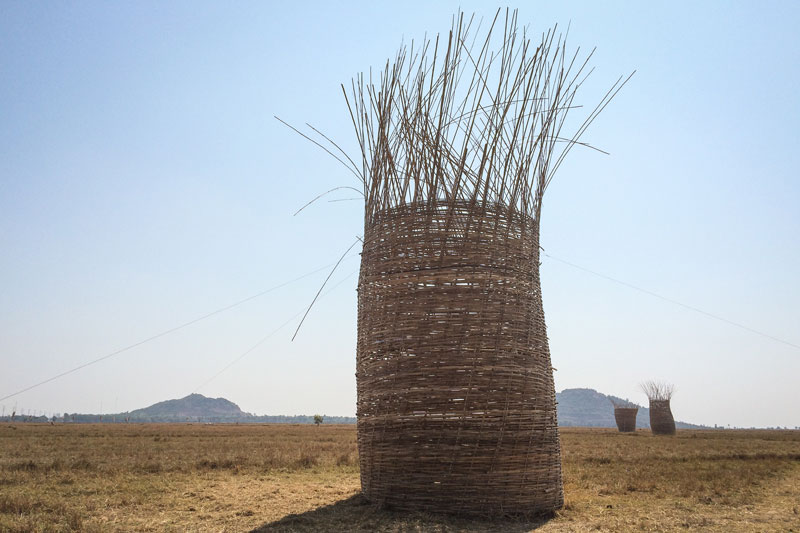PREAH NETR PREAH DISTRICT, Banteay Meanchey province – Driving on National Road 6 through recently harvested rice fields, six 10-meter-tall structures emerge like vortexes from the sparse terrain. Not far along is the commotion of a country fair: bale mazes, archery games, face painting, a ferris wheel and blaring Khmer pop music.
Welcome to “Rice, Life and Culture,” a three-day bale-art festival that opened Friday and ended Sunday, organized by the Banteay Meanchey provincial government and the Phnom Penh office of South Korea’s trade-promotion agency, Kotra.

Located about an hour’s drive from Siem Reap City, the festival in Phnom Liep commune was conceived by Kotra to cultivate Banteay Meanchey’s tourism potential and provide an alternative income source for locals.
Speaking at the opening of the festival on Friday, Banteay Meanchey governor Kousoum Saroeuth said he hoped such events would encourage visitors to spend some time in the province, home to the Poipet international border checkpoint.
“Four thousand tourists cross our province every day,” he said. “But they never stop over to spend money in our province.”
Foreign Designs
Before the bale-art festival, which drew about 1,000 visitors on its first day, Chong Dowon, agribusiness development manager at Kotra Phnom Penh, first had to introduce the practice of baling to local farmers.
Though bales are common on farms across Europe, North America and South Korea, leftover straw on Cambodian farms is usually burned after a rice harvest, or used to grow mushrooms. Packing the straw into uniform cuboids was completely novel to the 37 farmers that Kotra hired—for 25,000 riel (about $6.12) a day—to help erect the festival structures.
Mr. Chong imported an old South Korean baler and tractor and—with the help of the local farmers and about a dozen Kotra staff—spent three weeks constructing mazes, a house and a garden out of rice straw.
“There are two men in Cambodia who know how to use [the baler],” Mr. Chong said. There was the farmer he first trained to use the old machine, he said, and the man the farmer trained before he headed off to a wedding.
“It is an extraordinary thing since we have never had this before in our country,” said Thy Thea, 45, one of the visitors who, like most of his fellow Cambodians, had never seen bales of straw before the festival.
And the curiosity extended beyond the bales.
Walking past the maze, visitors were invited to walk along a path that opened to a rice field where six bizarre structures loomed.
Artist Choi Ok-young—flown in from South Korea nine days before the festival—directed locals in creating the six massive sculptures from woven bamboo. Visitors could walk inside the creations using underground stairs, re-emerging inside a structure that spiraled to the open sky.
The 56-year-old artist said the forms represented energy streams harvested from the land. But for the farmers who built them, the imagery was less clear.
“It is a strange and extraordinary thing for all of us,” said Chea Chhen, 59, one of the farmers who worked on the sculptures. “We did not know what they were trying to do and we just followed their orders,” he said, adding that each sculpture required three to four people working for three or four days.
Kotra Phnom Penh deputy director Kim Yun-gun said other villagers reached for more familiar references in interpreting the installations.
“They did not understand why we are making this kind of thing,” Mr. Kim said, explaining that some farmers decided to use the structures for a more practical reason—as outhouses.
“We had to clean it up,” he said, laughing.
But once the festival began, locals and visitors alike seemed to embrace the curiosities, with families snapping selfies in front of the soaring sculptures.
Sowing Tourism
The organizers of the festival see an untapped agritourism market in Cambodia. And Banteay Meanchey is the ideal place to start, according to Seo Jeong-ah, one of the organizers.
“Cambodia’s tourism industry is heavily focused on temples and remains,” Ms. Seo said. “Banteay Meanchey is the best place for this agriculture tourism because Banteay Meanchey has a lot of vast rice fields and it is relatively closer to Siem Reap, where many tourists come.”
Kotra Phnom Penh has already begun planning for the next festival—paddy art—in June. And to help increase visitors, Ms. Seo said they will partner with tour agencies to include the festival in packages for South Korean tourists, the second-largest group of visitors behind Chinese.
Governor Saroeuth said this weekend’s festival was a good start.
“When they stay longer, they need accommodation, food,” he said of tourists. “Our villagers make money through this and it provides work for the community to support their livelihood.”
Yet the promise of tourism in Bancheay Meanchey remains uncertain. Most of the villagers are more concerned with taking care of their crops, and flood-prevention plans, including expanding irrigation throughout the province, are yet to be implemented.
But for a few days, the villagers enjoyed the art—and a little extra income.
“We are very happy,” said Mr. Chhen, the farmer-sculptor. “We can learn about their [South Korean] culture and we can earn some money to support our family.”
(Additional reporting by Emily Townsend)



